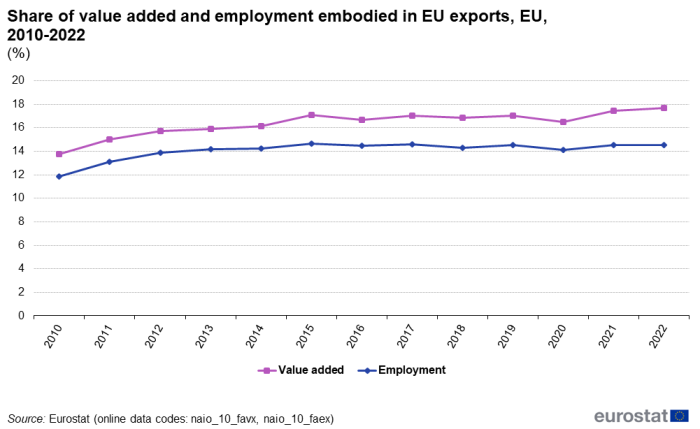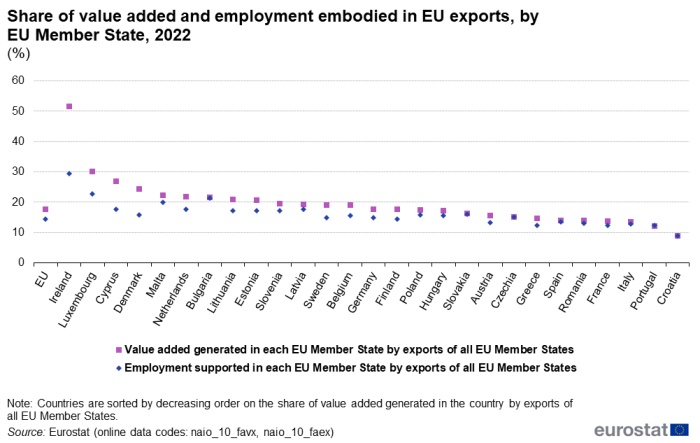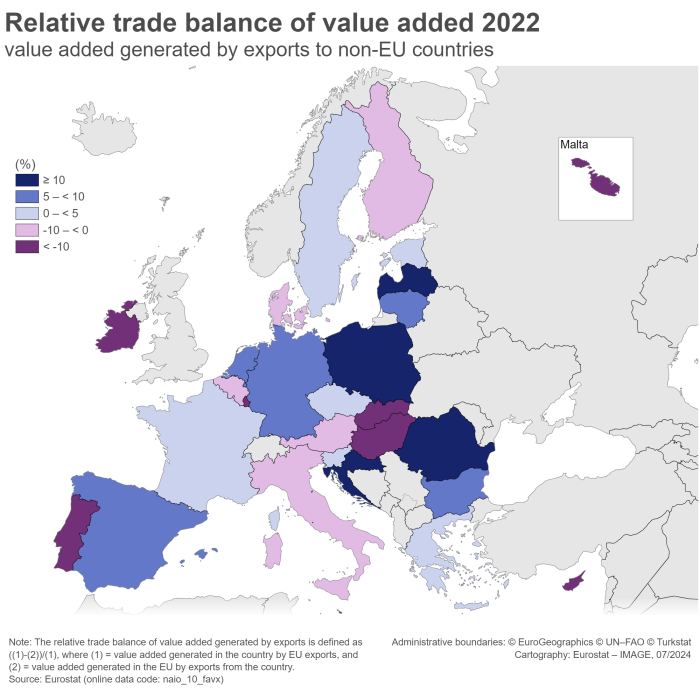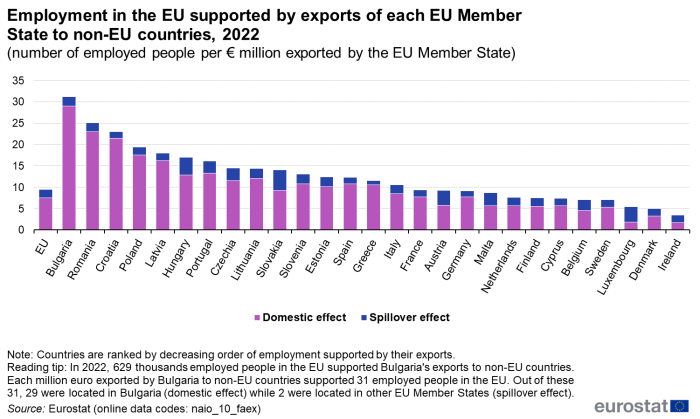Employment and value added in EU exports - an analysis with FIGARO data
Data extracted in July 2024
Planned article update: July 2025
Highlights
Share of value added and employment embodied in EU exports, EU, 2010-2022
The production of goods and services requires inputs, which may be sourced domestically or globally. The final value of a product may well reflect value that has been added in many different stages of the production chain through the combination of factors of production, including employment. Gross value added may have been generated and employment input may have been located in many different countries. This fact is not always visible in conventional trade statistics, which generally reflect the total value of a product when traded. An analysis of the gross value added and employment embodied in exports of goods and services can provide insight into international trade relations.
This article aims to provide deeper insights into gross value added and employment in the European Union (EU) associated to exports of EU countries to non-EU countries. This is done by analysing the gross value added and employment embodied in the EU exports using the FIGARO tables – full international and global accounts for research in input-output analysis – and the Leontief input-output model (Miller and Blair, 2009). For more information, see the Data Sources and Context sections below.
Full article
Trends for the EU as a whole
In 2022, EU exports to non-EU countries generated €2 526 billion of gross value added in the EU; this represented 17.7% of the EU total gross value added (€14 304 billion) (see Figure 1). Compared to 2021, the share of gross value added generated by EU exports increased by 0.2 percentage points (pp) (from 17.5%). Comparison with 2010 even shows a rise of 3.9pp (from 13.8%).
In 2022, in terms of employment, the jobs of 31.1 million people in the EU was supported by exports to non-EU countries. These employed people accounted for 14.5% of the total EU employment (214.4 million). Between 2021 and 2022, the share of employed people supported by EU exports remained stable. However, from 2010 to 2022 it increased by 2.6 pp (from 11.9%).

(%)
Source: Eurostat (naio_10_favx) and (naio_10_faex)
Half of the countries are in the net beneficiaries from spillover effects section, the other half in the net contributions of spillover effects sections. Each country has two columns representing employment in each EU country supported by exports of all EU countries to non-member countries and employment in the EU supported by exports of each EU country to non-member countries for the year 2021.]]
Regardless of whether presenting data for the EU as a whole or for individual countries, all references to exports in this article concern exports to non-EU countries, in other words extra-EU exports. Direct trade among EU countries is not considered except when it is part of a value chain ending up in a product exported to non-EU countries. Also, all references to value added should be understood as gross value added (GVA).
Figure 1 shows that the share of value added and employment embodied in EU exports to non-EU countries follow a similar trend between 2010 and 2022. The sharpest drop for both value added and employment was due to the COVID-crisis (-0.6 pp and -0.5 pp respectively, between 2019 and 2020) while the biggest annual increase for value added was linked to the COVID recovery (+1.0 pp between 2020 and 2021)and the one for employment was recorded much earlier between 2011 and 2012 (+0.8 pp).
Effect in each EU country of EU exports to non-EU countries
Germany was the EU country that generated the most value added from EU exports: in 2022, €624.5 billion of value added in Germany was due to exports from the EU, including from Germany itself. The level of export-generated value added in Germany was more than the combined level of export-generated value added in France (€323.3 billion) and Ireland (€247.3 billion), which had the second and third highest levels.
However, Germany’s economy being the largest among EU countries, these absolute figures may provide a limited perspective. To address this, Figure 2 illustrates the ratio of the value added generated by EU exports to the total value added by EU country. Looking at Figure 2, the EU country that relied most on EU exports was Ireland with more than half of its total value added generated by EU exports (51.6%), followed by Luxembourg (30.2%) and Cyprus (27.0%). By contrast, the lowest shares of value added were recorded in Croatia (9.0%) and Portugal (12.1%). Italy (13.6%), France (13.7%), Romania (13.9%), Spain (14.0%) and Greece (14.7%) had also relatively small shares of value added generated by EU exports, i.e. all less than 15%.

(%)
Source: Eurostat (naio_10_favx) and (naio_10_faex)
The EU country with the highest employment supported by EU exports was also Germany: in 2022, the employment of 6.8 million people Germany was supported by exports from the EU, including from Germany itself. The level of export-supported employment in Germany was in this case slightly less than the combined level of export-supported employment in France (3.7 million people) and Italy (3.3 million people), which had the following highest levels. As a share of total employment, the employment supported by EU exports in each of the EU countries ranged from one in five or more in Ireland (29.5%), Luxembourg (22.7%), Bulgaria (21.5%) and Malta (20.0%) to less than one in ten in Croatia (9.0%). As for the value added, the share of employment supported by EU exports was relatively low for Greece (12.3%), France (12.4%), Portugal (12.5%) and Italy (12.8%), i.e. all less than 13%.
Effect in the EU of exports from each EU countries to non-EU countries
Besides the estimation of the value added generated and employment supported in each EU country as a result of EU exports, the FIGARO tables can also provide insight into the value added and the employment anywhere in the EU that is generated or supported by the exports from a particular EU country.
Figure 3 compares the two indicators for the value added, i.e. it shows on one hand the value added generated in each EU country by exports of all EU countries to non-EU countries, and on the other hand the value added generated in the EU by exports of each EU country to non-EU countries. In 2022, Ireland was the country where the value added (in Ireland) due to EU exports (including from Ireland) was the smallest in comparison with the value added across the EU (some of which in Ireland) generated by exports from Ireland alone: the difference between the two indicators amounted to €-37.4 billion (€247.3 billion versus €284.7 billion). Consequently, Ireland was the largest net contributor to value added in the other EU countries.

(€ million)
Source: Eurostat (naio_10_favx)
Italy, Luxembourg and Hungary followed with differences of €-13.3 billion, €-7.5 billion and €-6.3 billion respectively. These four countries, together with Slovakia, Denmark, Finland, Austria, Portugal, Malta, Belgium and Cyprus, received smaller benefits (in value added terms) from the exports of other EU countries than the benefits they provide in other EU countries through their own exports. They were net contributors of cross-border spillover effects (see Box 1).
Box 1: What are domestic and spillover effects?
The domestic effect is value added (employment resp.) in a given EU country that is generated (supported resp.) by its own exports. This value added (employment resp.) may be in the same industry as the one that exports the goods or services (direct domestic effect) or in another industry (indirect domestic effect). As such, the indirect domestic effect is effectively an industry spillover effect within a single EU country – it is the value added (employment resp.) in a particular industry that is generated (supported resp.) by the exports of a different industry (within the same EU country).
This article does not present the split of the domestic effect into direct and indirect effect but this one can be computed using the Eurostat dissemination datasets (naio_10_favx) for the value added and (naio_10_faex) for the employment and dividing the economy into the different industries (according to the NACE activity classification).
The spillover effect reflects the value added (employment resp.) in a given EU country that is generated (supported resp.) by the exports of other EU countries. For example, it includes value added (employment resp.) in a country engaged in the production of intermediate inputs to be used in other EU countries' exports to non-EU countries.
Conversely, EU countries on the right-hand side of Figure 3 received greater benefits from the exports of the other EU countries than the benefits they provide in the other EU countries through their own exports. They were therefore net beneficiaries from cross-border spillover effects. For example, €624.5 billion of value added in Germany was generated by exports from all EU countries (including from Germany), whereas €591.8 billion of value added across the EU (some of which in Germany) was generated by exports only from Germany. The difference – with Germany being a net beneficiary – was €32.7 billion. Similarly, the Netherlands, Poland, Spain, France and Romania (by decreasing order), as well as Bulgaria, Czechia, Lithuania, Sweden, Latvia, Croatia, Greece, Slovenia and Estonia although in a lesser extent, were net beneficiaries from cross-border spillover effects.
Trade balance
The difference between the value added generated (employment supported resp.) in each EU country by EU exports and the value added generated (employment supported resp.) anywhere in the EU by exports from a particular EU country can be considered as the trade balance of value added generated (employment supported resp.) by exports to non-EU countries. Indeed, it shows if a particular EU country is a net contributor to or a net beneficiary from the value added (employment resp.) of the other EU countries. Map 1 presents the results in relative terms for the value added for the year 2022.

(€ billion)
Source: Eurostat (naio_10_favx)
The relative trade balance of value added generated by exports to non-EU countries, being the trade balance of value added divided by the value added generated in the concerned EU country by EU exports, was the highest in 2022 for Romania, Croatia (both +12%), Poland (+11%) and Latvia (+10%). These four countries were relatively the greatest net beneficiaries from cross-border spillover effects.
In contrast, Malta (-47%), Luxembourg (-35%), Slovakia (-27%), Hungary (-26%), Ireland (-15%), Cyprus (-14%) and Portugal (-11%) contributed relatively the most with their exports to non-EU countries to the production of value added in the other EU countries. For all these seven countries, the relative trade balance of value added generated by exports is indeed lower than -10%.
Values per € million exported
To compare more easily the value added generated (the employment supported resp.) in the EU by the exports of each EU country, its relative size to the total exports of the considered EU country can be looked at. Figure 4 presents the results for both value added and employment for the year 2022.

(value added in thousands, employment in number of employed people)
Source: Eurostat (naio_10_favx) and (naio_10_faex)
In the EU as a whole, in 2022, each million euro exported to non-EU countries generated €767 thousands of value added and supported 9 employed people in 2022. At national level, in terms of EU value added per € million exported by each country, Romania recorded the highest figure, with €840 thousands of value added generated in the EU due to the Romanian exports. Austria, Croatia and Germany followed with €824, €821 and €818 thousands of value added per € million exported respectively. By contrast, the lowest figures of value added per € million exported can be found in Greece (€561 thousands), Cyprus (€576 thousands) and Malta (€611 thousands).
In terms of EU employment, Bulgaria registered the highest number of people employed in the EU supported by national exports to non-EU countries per € million exported, namely 31 people. Romania ranked second for the employment with 25 EU employed people supported by Romanian exports. Croatia closely followed with 23 EU employed people supported by Croatian exports. Conversely, Irish, Danish and Luxembourgish exports relatively supported very few employed people in the EU (3, 5 and 5 people per € million exported respectively).
Domestic and spillover effects
The EU value added generated (the EU employment supported resp.) by the exports of each EU country per € million exported, as presented in the previous section, can be divided up into two parts: the domestic effect and the spillover effect (see Box 1). The values for the EU employment related to these two effects are presented in Figure 5 for the year 2022.

(number of employed people per € million exported by the EU Member State)
Source: Eurostat (naio_10_faex)
At EU level, out of the 9.5 employed people per € million exported in 2022, 7.6 related to a domestic effect (employment located in the exporting EU country) while 1.9 were due to cross-border spillover effects (employment located in other EU countries).
Among the EU countries, the highest contribution of the domestic effect in the number of employed people per € million exported occurred in Bulgaria, with 29.1 employed people. Romania and Croatia followed with 23.1 and 21.5 employed people respectively. The lowest relative contributor of the domestic effect was Ireland, with 1.7 people employed per € million exported. Concerning the cross-border spillover effects, the largest contribution in the number of employed people per € million exported could be found in Slovakia (4.8 people employed per € million exported), followed by Hungary (4.1 employed people). By contrast, the smallest contribution of the cross-border spillover effects was recorded in Greece, with 1.1 people employed in other EU countries due to its own exports to non-EU countries per € million exported. Germany, Spain and Croatia were also relative low contributors to the cross-border spillover effects, with 1.5 people employed in other EU countries per € million exported.
Source data for tables and graphs
![]() Source data for the figures and the map
Source data for the figures and the map
All FIGARO data for value added are available from the following Excel files:
2010 2011 2012 2013 2014 2015 2016 2017 2018 2019 2020 2021 2022
All FIGARO data for employment are available from the following Excel files:
2010 2011 2012 2013 2014 2015 2016 2017 2018 2019 2020 2021 2022
They can also be accessed through the Eurostat dissemination database: (naio_10_favx) and (naio_10_faex)
Data sources
Concept
The FIGARO tables are a statistical product of the integrated global accounts for economic modelling. They link national accounts and data on business, trade and employment for the EU Member States and 18 main EU trading partners of the EU (Argentina, Australia, Brazil, Canada, China, India, Indonesia, Japan, Mexico, Norway, Russia, Saudi Arabia, South Africa, South Korea, Switzerland, Türkiye, the United Kingdom and the United States). A 'rest of the world' region completes the FIGARO tables.
The FIGARO tables present the relationship between economies at a detailed level of 64 industries and 64 products, as defined in the ESA 2010 national accounts transmission programme.
The three following main applications are produced based on the FIGARO tables:
- employment supported by EU exports to the rest of the world,
- value added supported by EU exports to the rest of the world,
- greenhouse gas footprints linked to final consumption and investment in the EU.
The value added (employment resp.) in the EU or in individual EU Member States embodied in exports includes not only value added (employment resp.) by enterprises that are directly exporting, but also by those supplying goods and/or services for the production of exported goods and services; in other words, it also includes value added (employment resp.) by upstream enterprises. This may concern value added (employment resp.) by enterprises in the same industry as the exporter or in a different one (depending, in part, how detailed an activity classification is used). Equally, exports by enterprises in one EU Member State may support value added (employment resp.) in the same exporting Member State or in a different one.
Frequency and availability
The FIGARO tables are produced and updated annually, as are the results for the three main FIGARO applications. In 2024, the time series from 2010 to 2022 has been published (period t–24 months, t being the year of release). The time series is in line with the latest macroeconomic aggregates.
More information
For more information, please refer to the dedicated section for the supply, use, input-output and FIGARO tables.
Context
Partners
The FIGARO tables are the result of a long-term collaboration between Eurostat and the European Commission's Joint Research Centre. Both partners also collaborate within the GIANT initiative (Global Input-Output Accounts), comprising the Asian Development Bank (ADB), the International Monetary Fund (IMF), the United Nations Economic Commission for Latin America and the Caribbean (UN-ECLAC), the United Nations Economic Commission for Africa (UN-ECA), and the World Trade Organisation (WTO), which aims to explore synergies and common action among the various initiatives on the compilation of multi-country (extended) supply, use, and input-output tables.
Purpose
The FIGARO tables provide the first official inter-country supply, use and input-output data for the EU. They are a tool for analysing the social, economic and environmental effects of globalisation. These may be analysed through studies on competitiveness, growth, productivity, employment, environmental footprint and international trade (for example, analyses of global value chains).
The tables are used to evaluate EU policies and assess the economic interdependencies of the EU (or the euro area or individual EU Member States) in a globalised world.
Direct access to
- Data can be accessed through the dedicated section as CSV files (flat or matrix format) and Excel files.
- Data are also available from the Eurostat dissemination database: (naio_10_favx)